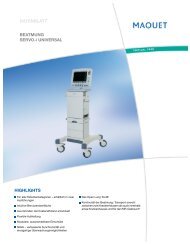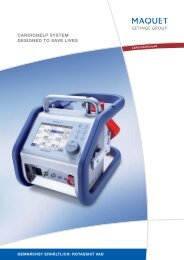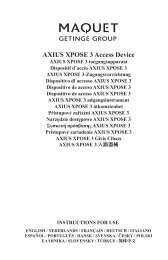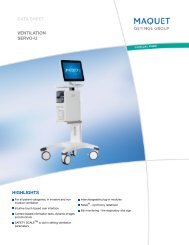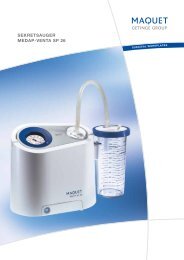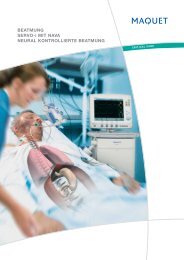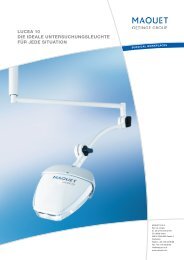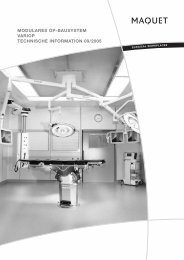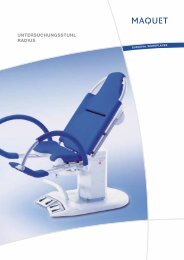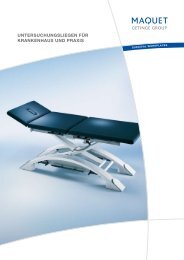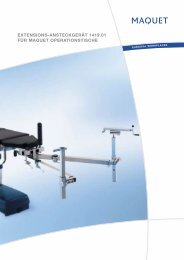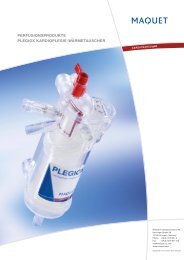challenges in critical care: geisinger medical center - Maquet
challenges in critical care: geisinger medical center - Maquet
challenges in critical care: geisinger medical center - Maquet
You also want an ePaper? Increase the reach of your titles
YUMPU automatically turns print PDFs into web optimized ePapers that Google loves.
| 2 | Geis<strong>in</strong>ger Hospital | Critical Care |<br />
WORLD-RENOWNED MEDICAL CENTER SERVING CENTRAL AND<br />
NORTHEASTERN PENNSYLVANIA FINDS NIV OPTION ON SERVO-i<br />
VENTILATORS VALUABLE TREATMENT ALTERNATIVE.<br />
GEISINGER MEDICAL CENTER<br />
SERVO-i <strong>in</strong> use at bedside<br />
For more than 90 years, Geis<strong>in</strong>ger Medical Center<br />
<strong>in</strong> Danville, Pennsylvania, has been known as the<br />
region’s resource for the highest quality health<strong>care</strong>.<br />
Its physicians, all of whom are connected by a sophisticated<br />
electronic <strong>medical</strong> record system, practice <strong>in</strong> more than 75<br />
<strong>medical</strong> specialties. Thanks to its highly regarded expertise<br />
and its use of the most advanced technology <strong>in</strong> the country,<br />
the most complex cases <strong>in</strong> Central and Northeastern<br />
Pennsylvania often are referred to the 437-bed <strong>medical</strong> <strong>center</strong>.<br />
As one of the nation’s top <strong>medical</strong>/surgical and Level 1 trauma<br />
<strong>center</strong>s with supplementary accreditation <strong>in</strong> pediatrics,<br />
Geis<strong>in</strong>ger must have state-of-the-art equipment and procedures<br />
for acutely ill patients. For patients with acute respiratory<br />
illnesses, the hospital has a fleet of 45 SERVO-i ventilators.<br />
It recently upgraded its fleet to <strong>in</strong>clude software for non<strong>in</strong>vasive<br />
(NIV) functionality.<br />
NIV is a valuable treatment alternative for acute hypercapneic<br />
respiratory failure, particularly <strong>in</strong> patients with chronic<br />
obstructive pulmonary disease (COPD). The hospital sees many<br />
COPD patients, particularly among its elderly patient population,<br />
says John Conrad, BS, RRT-NPS, RCP, Adm<strong>in</strong>istrative Team<br />
Leader for the Respiratory Care Services. Also, NIV can be<br />
effective <strong>in</strong> cardiogenic pulmonary edema (CPE) as well as<br />
dur<strong>in</strong>g wean<strong>in</strong>g, he says.<br />
Non-<strong>in</strong>vasive ventilation helps avoid some of the complications<br />
that can be associated with <strong>in</strong>vasive ventilation, such as<br />
discomfort, <strong>in</strong>fections and airway trauma. NIV also can shorten<br />
hospital stays for select patients, reduc<strong>in</strong>g their treatment costs,<br />
Conrad says.<br />
SERVO trend<strong>in</strong>g package makes monitor<strong>in</strong>g set<br />
pressure for patients on NIV easy. As a Respiratory<br />
Therapist, Mark Reffner, BS, RRT, RCP, f<strong>in</strong>ds the NIV option<br />
on the SERVO-i easy to employ. Dur<strong>in</strong>g NIV, the ventilator<br />
automatically adapts to variations <strong>in</strong> leakage to ma<strong>in</strong>ta<strong>in</strong> the<br />
required pressure and positive end-expiratory pressure (PEEP)<br />
level, he says. The leakage percentage is one of the values<br />
displayed under trends, mak<strong>in</strong>g it easier to make adjustments<br />
as needed. “It is possible, by measur<strong>in</strong>g and adjust<strong>in</strong>g dur<strong>in</strong>g<br />
the same breath, to ma<strong>in</strong>ta<strong>in</strong> the set pressure to the patient,”<br />
he says.<br />
Jennifer M. Small, RRT, RCP, Adult Critical Care Team Leader,<br />
f<strong>in</strong>ds most patients tolerate NIV extremely well, especially if they<br />
are relaxed. To make patients comfortable, she often holds the<br />
facemask <strong>in</strong> place for a few m<strong>in</strong>utes before strapp<strong>in</strong>g it on.<br />
The SERVO-i ventilator does not require any proprietary <strong>in</strong>terface.<br />
Many masks and harnesses are available <strong>in</strong> several designs<br />
and materials as patients have different facial contours.<br />
To standardize <strong>care</strong>, Geis<strong>in</strong>ger has adopted protocols for how<br />
supportive therapy is <strong>in</strong>itiated, ma<strong>in</strong>ta<strong>in</strong>ed, and discont<strong>in</strong>ued<br />
to alleviate a patient’s work of breath<strong>in</strong>g, and to ensure adequate<br />
oxygenation and ventilation. The overall goal of Geis<strong>in</strong>ger’s<br />
ventilator management protocol is to have all patients on<br />
mechanical ventilation for the shortest time possible. This helps<br />
reduce the <strong>in</strong>cidence of Ventilator Associated Pneumonias<br />
(VAP), s<strong>in</strong>ce patients who are <strong>in</strong>tubated greater then forty-eight<br />
hours are more susceptible to VAP. Patients are assessed<br />
at least every four hours, and a wean is attempted based<br />
on the patient’s tolerance and criteria listed <strong>in</strong> the Geis<strong>in</strong>ger<br />
Ventilation Management Protocol. Patient <strong>in</strong> a facemask for non-<strong>in</strong>vasive ventilation<br />
| Critical Care | Geis<strong>in</strong>ger Hospital | 3 |<br />
Geis<strong>in</strong>ger’s protocol is based on the ARDSnet protocol, and<br />
was developed by their Pulmonary and Adult Critical Care<br />
physicians. The protocol allows the therapists to use their<br />
knowledge and expertise to <strong>care</strong> for <strong>in</strong>vasively and non<strong>in</strong>vasively<br />
mechanically ventilated patients. A section of its<br />
Respiratory Care Services Manual, Ventilation Management<br />
Protocol, addresses non-<strong>in</strong>vasive, positive pressure ventilation<br />
(NPPV). The RTs on staff are well respected, and work closely<br />
with physicians <strong>in</strong> f<strong>in</strong>d<strong>in</strong>g the right sett<strong>in</strong>gs and appropriate<br />
mode of ventilation for patients who need assistance breath<strong>in</strong>g,<br />
Small says. Hav<strong>in</strong>g the SERVO-i ventilators makes deliver<strong>in</strong>g<br />
the most appropriate, state-of-the-art <strong>care</strong> for each patient<br />
possible, she says.



